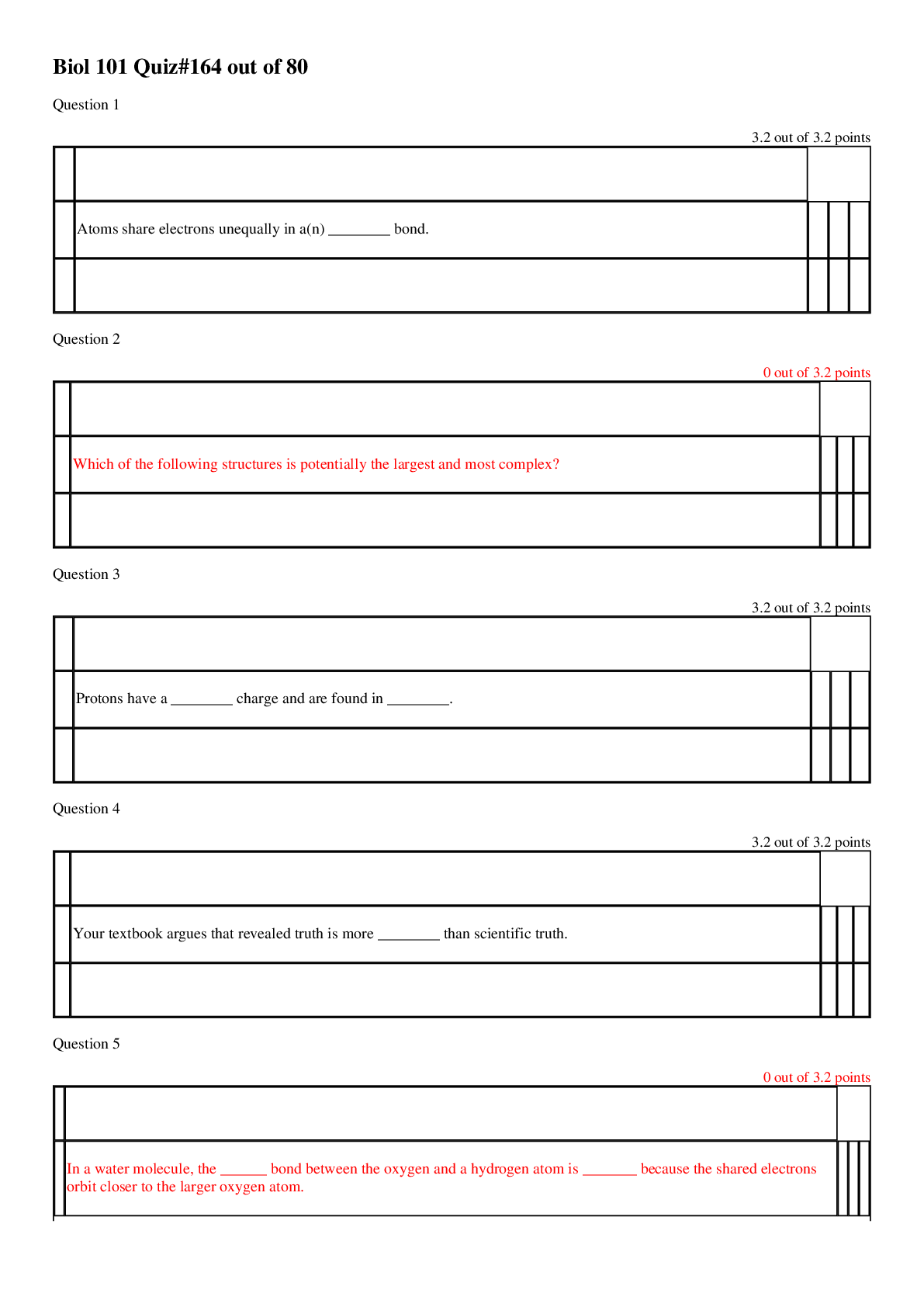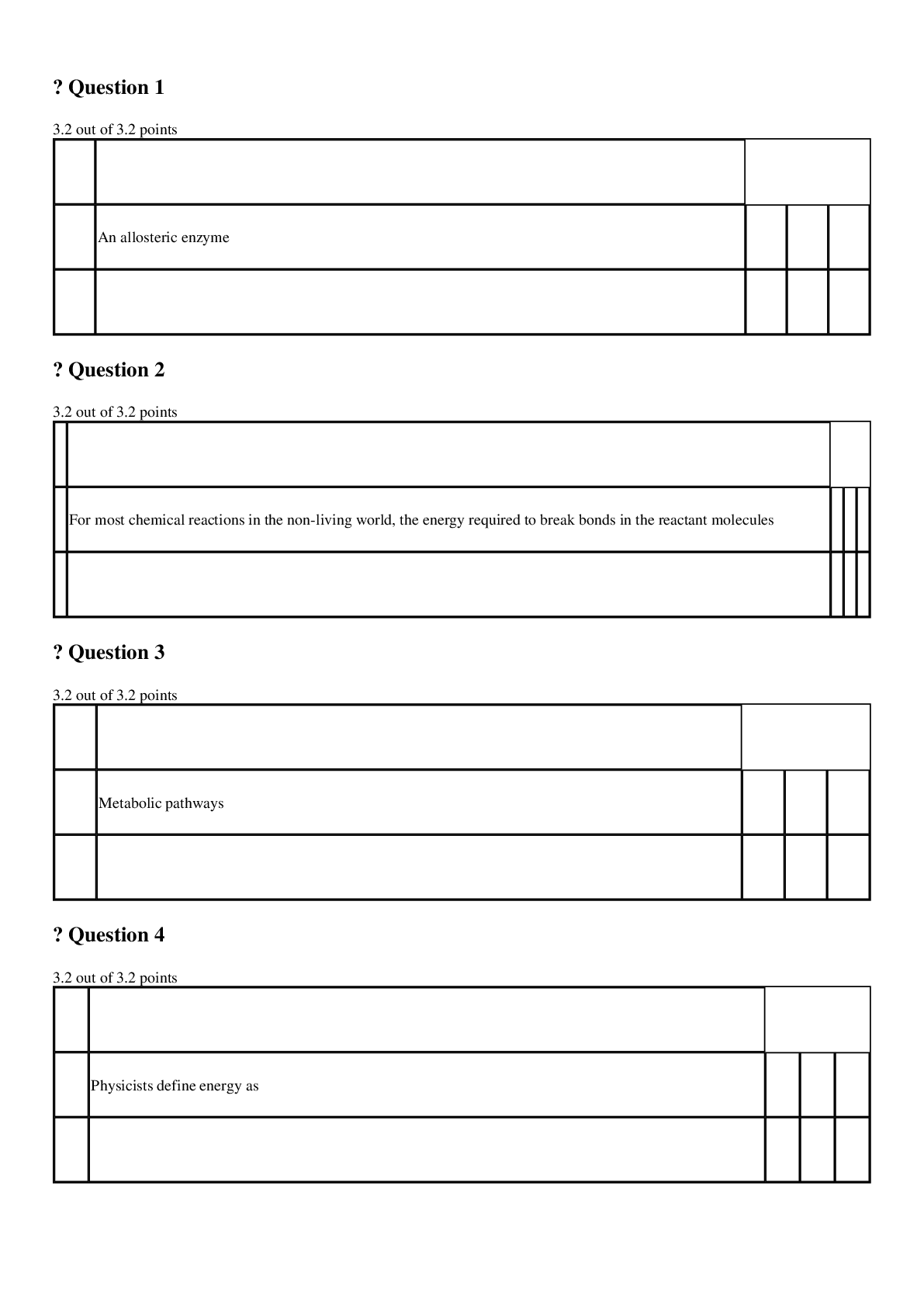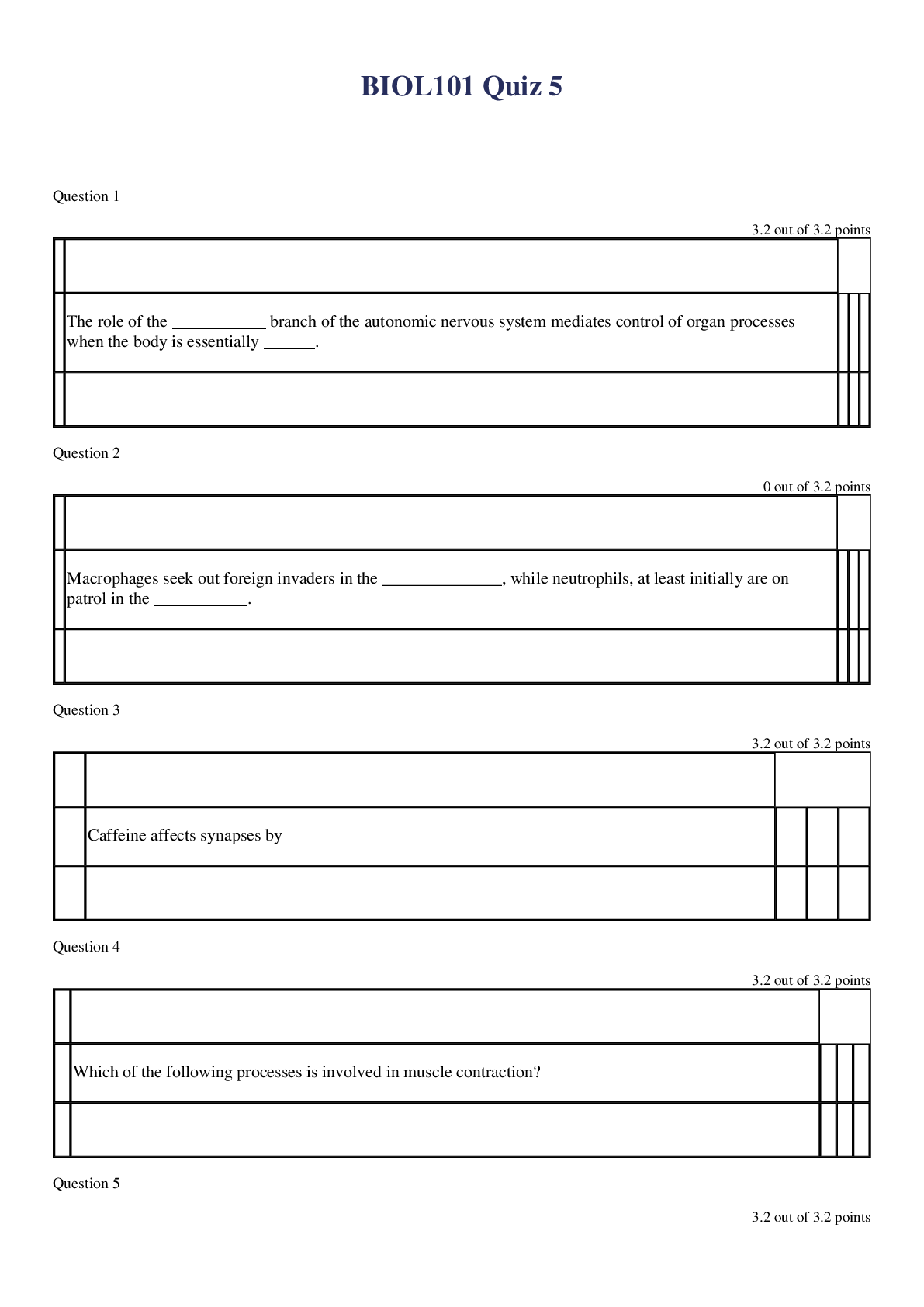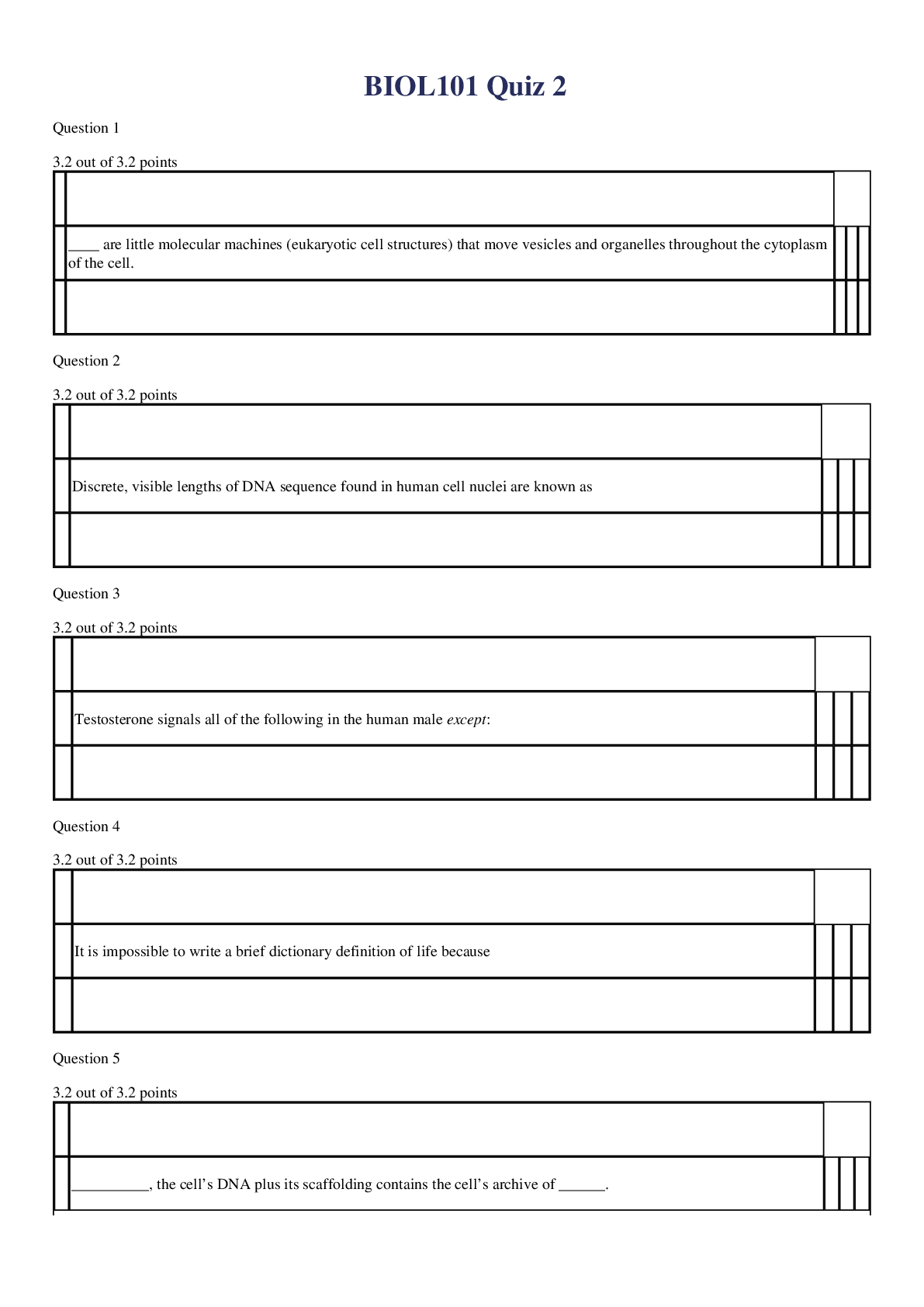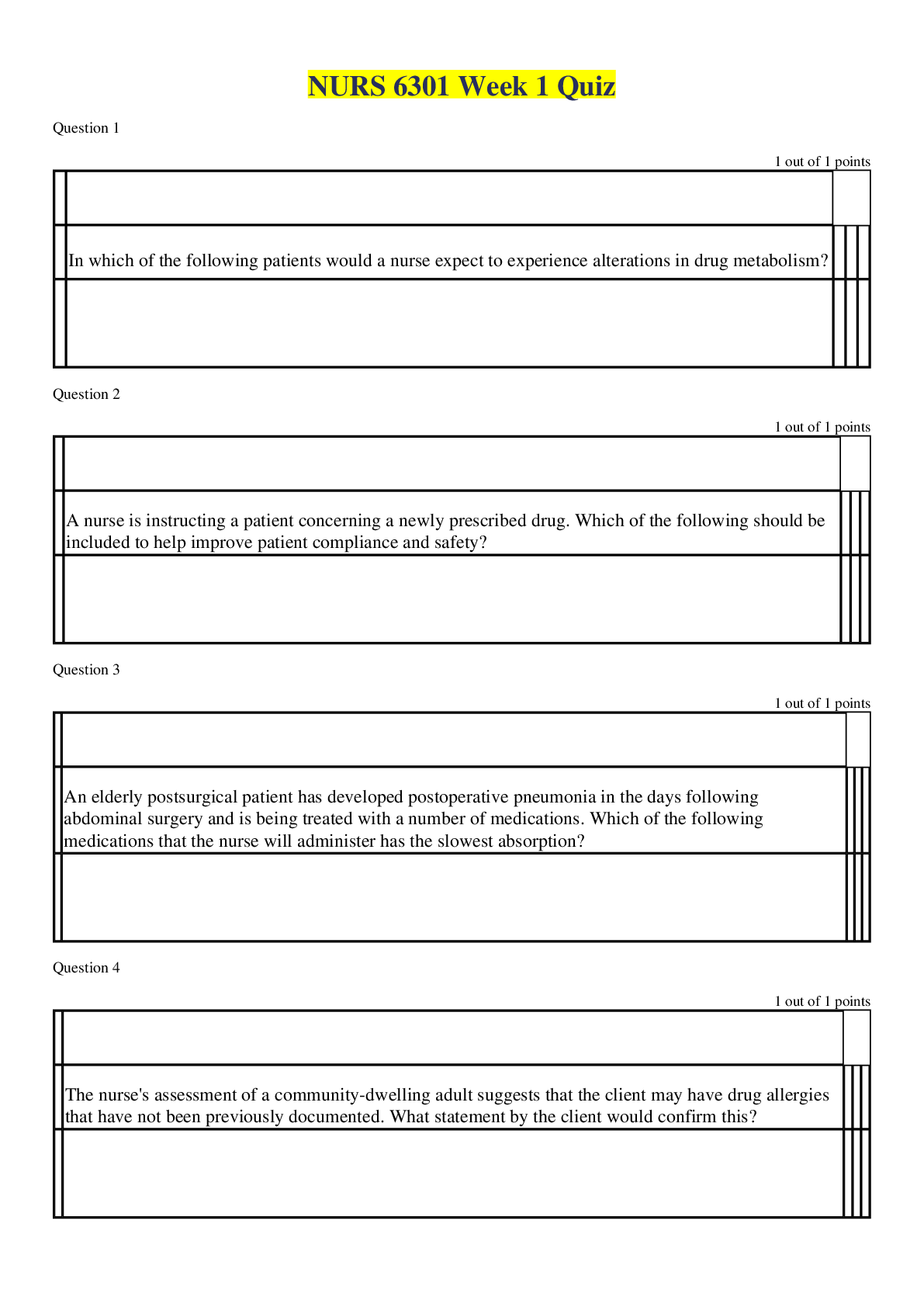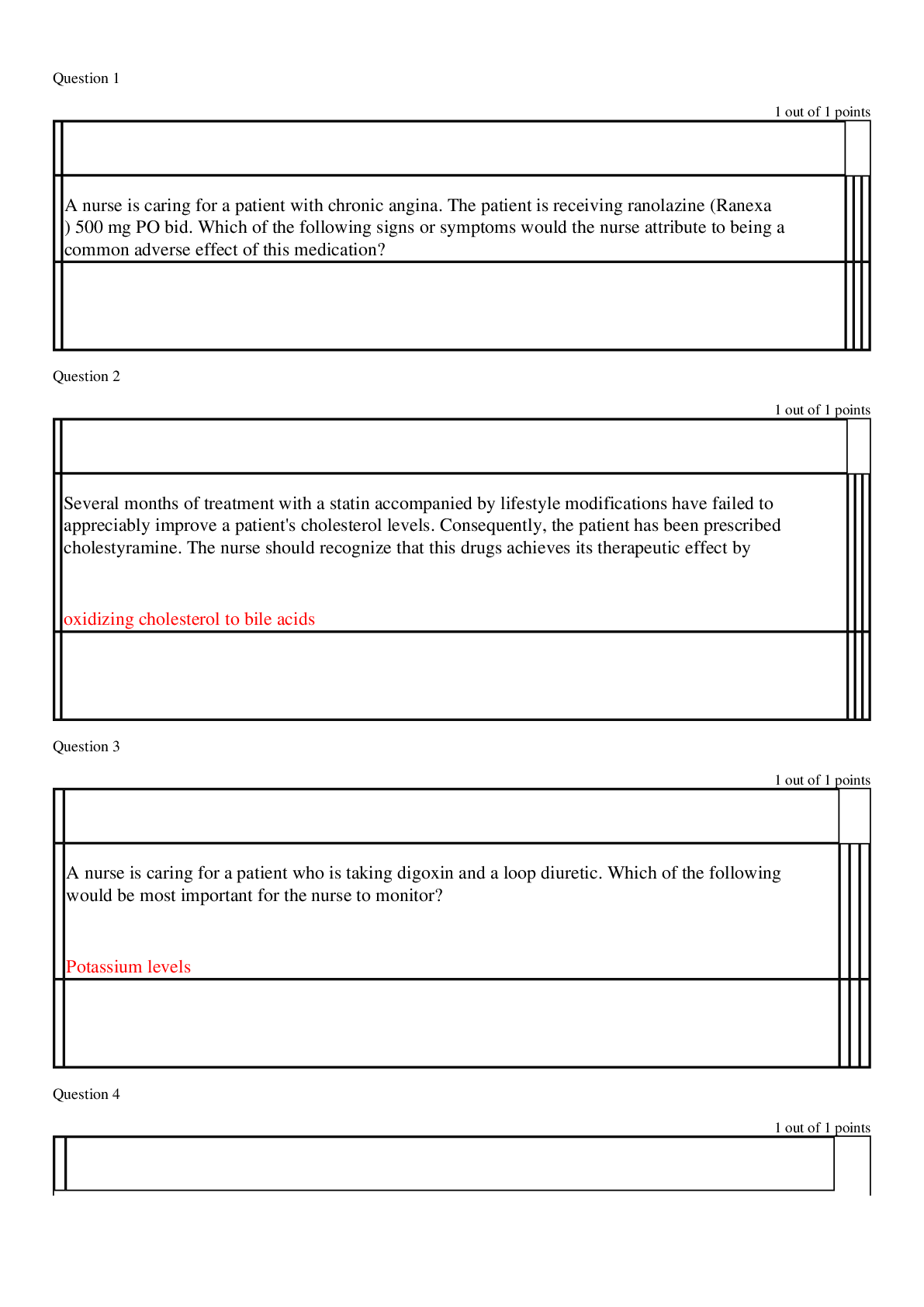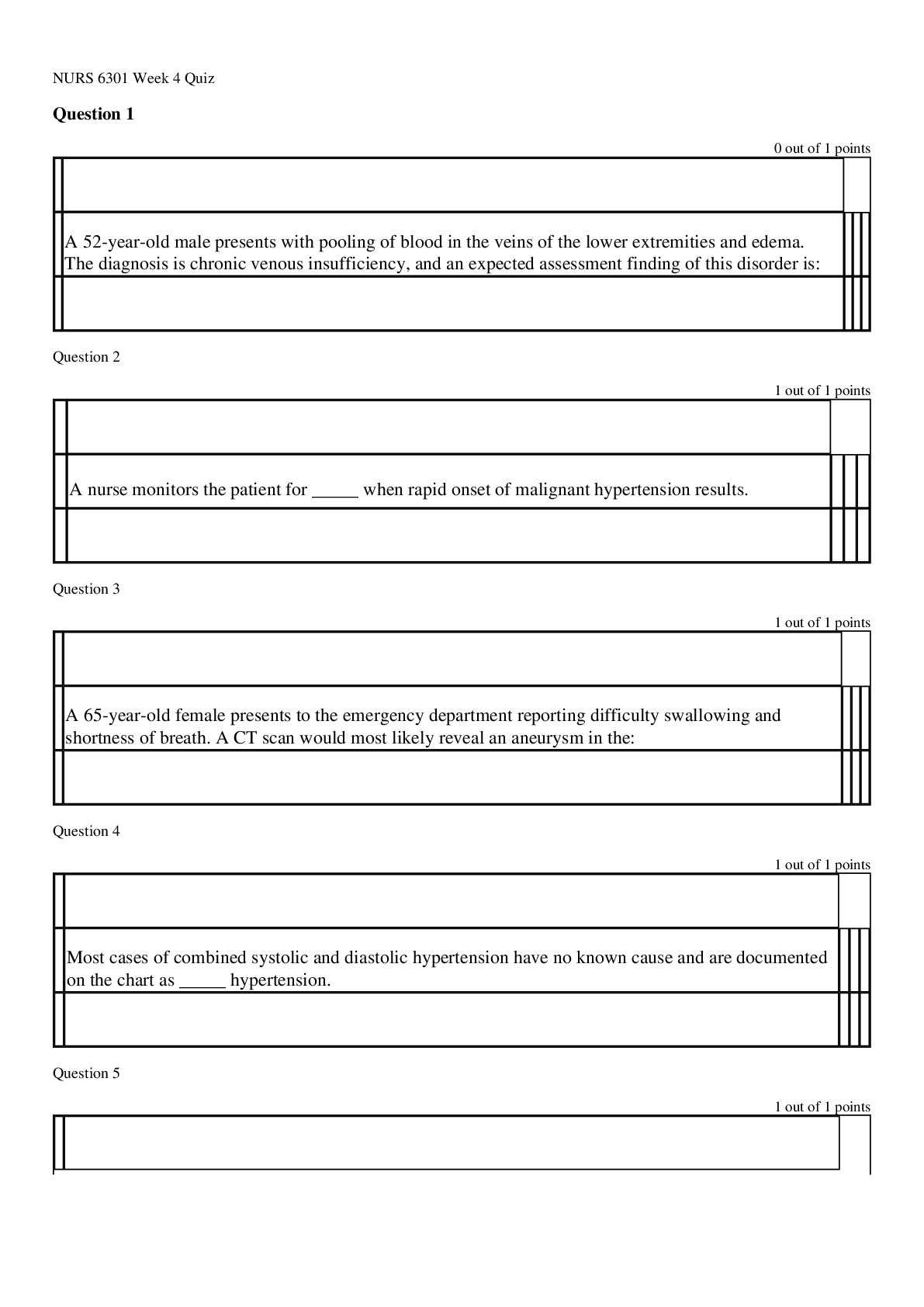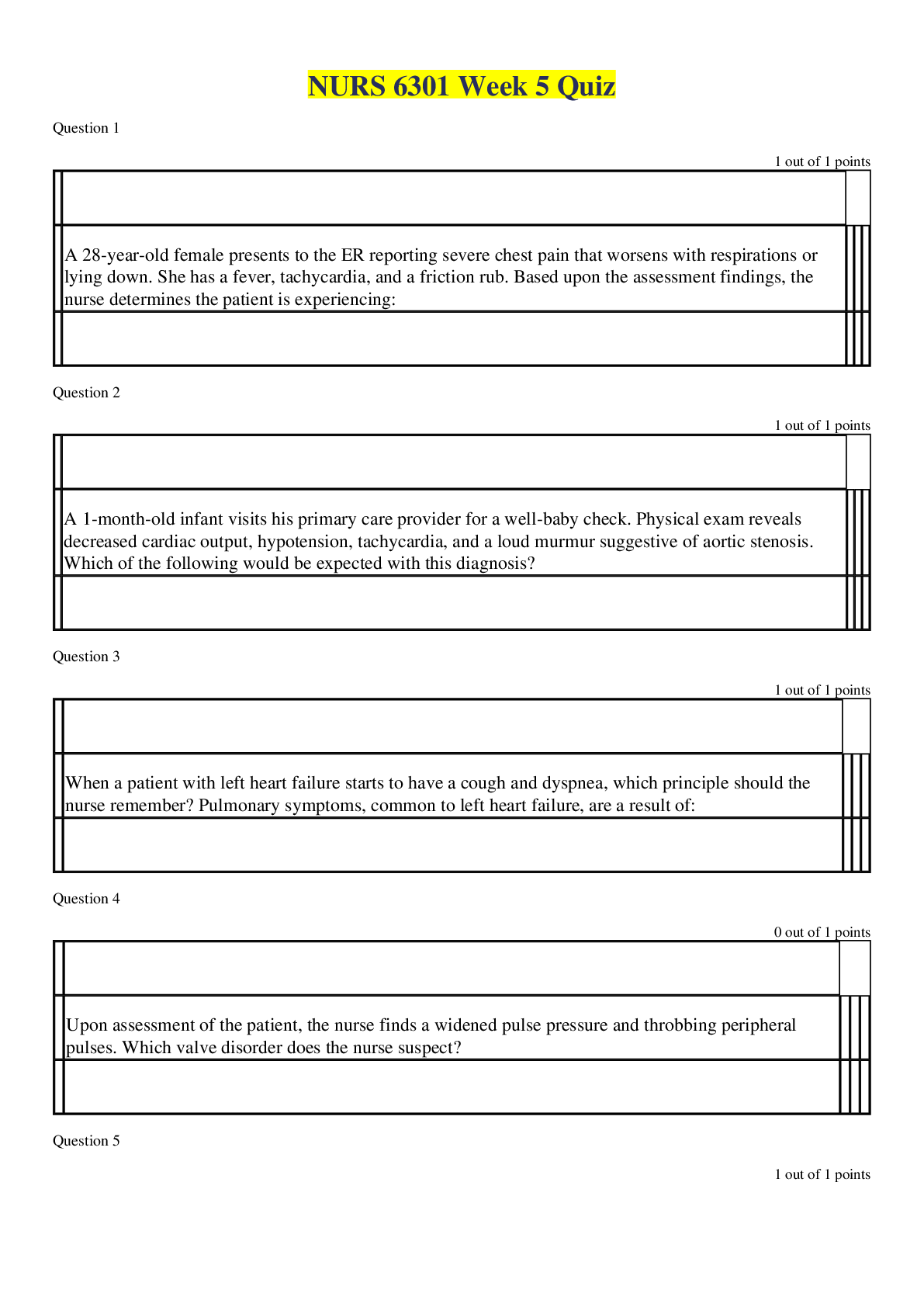*NURSING > EXAM > NSG 6320 AGNP BOARD EXAM QUESTIONS latest Assessment of Gastroenterology (84 Questions) – South Un (All)
NSG 6320 AGNP BOARD EXAM QUESTIONS latest Assessment of Gastroenterology (84 Questions) – South University Savannah | 100% CORRECT ANSWERS
Document Content and Description Below
NSG 6320 AGNP BOARD EXAM QUESTIONS latest Assessment of Gastroenterology (84 Questions) – South University Savannah Question: When percussing a protuberant abdomen, tympany is audible. This is c... onsistent with all of the following conditions except: intestinal obstruction. increased intestinal gas production. a large solid tumor. a paralytic ileus. Explanation: A protuberant abdomen that is tympanic throughout when percussed can suggest intestinal obstruction, increased gas production, or a paralytic ileus. A solid mass gives a dull sound on percussion. Question: Stool that appears bloody, mucoid, or with pus, may indicate: constipation. a lesion in the sigmoid colon. hemorrhoids. Crohn's disease. Explanation: Crohn's disease usually presents with blood, mucus, or pus in the stool. Thin, pencil-like stool occurs in an obstructing “apple-core” lesion of the sigmoid colon. Constipation produces hard, dry stool. In the presence of hemorrhoids, the stool may appear blood streaked. Question: A patient was recently diagnosed with gluten intolerance and needs instructions on what foods to eat. The patient should be told that a gluten restricted diet includes: corn. wheat. barley. rye. Explanation: A gluten-free diet is a diet that excludes the protein gluten. Gluten is found in grains such as wheat, barley, rye and triticale (a cross between wheat and rye). Corn and rice, and soybean products are allowed but processed foods are not. Question: A patient presents with symptoms of bloody stools, new onset constipation, and weight loss. These symptoms could be associated with: hemorrhoids. colon cancer. ischemic colitis. adenomatous polyps. Explanation: Colon cancer can cause bloody stools but usually presents with changes in bowel habits and weight loss. Lower abdominal pain accompanied by fever or shock in older adults could be consistent with ischemic colitis. Generally, the abdomen is soft on palpation. Hemorrhoids typically present with noticeable blood on the tissue paper, surface of stool, or dripping in the toilet. Blood in the stool is usually the only symptom seen with adenomatous polyps. Question: Spider angiomas, palmar erythema, and Terry's nails can be associated with: chronic renal failure. leukemia. liver disease. infective endocarditis. Explanation: Jaundice, spider angiomas and other telangiectasias, palmar erythema, Terry’s nails, pruritus, purpura, and caput medusae are skin conditions associated with liver disease. These skin conditions are not seen in patients who have chronic renal failure, leukemia, or infective carditis. Question: Which is NOT a mode of transmission for hepatitis C? Intravenous (IV) drug use Transfusion of unscreened blood Sexual intercourse Breast milk Explanation: Hepatitis C is not spread through breast milk, food, water or by casual contact such as hugging, kissing and sharing food or drinks with an infected person. Hepatitis C is transmitted by intravenous drug use, sexual intercourse, and transfusion of unscreened contaminated blood. Question: In the abdominal assessment of a 2-year-old, which one of the following would be considered abnormal? A pot belly. Tinkling sounds audible every 10-20 seconds on auscultation. The liver palpable 4 cm below the right costal margin (RCM). A palpable spleen 2 cm below the left costal margin (LCM). Explanation: The normal findings for a 2-year-old are a pot belly, spleen located 2 cm below the LCM, and tinkling sounds heard every 10-30 seconds. The liver should be approximately 1-3 cm palpable below the RCM; 4 cm is considered abnormal. Question: Percussion of the abdomen should be avoided when: trying to determine if the bladder is full. trying to detect the size of an abdominal organ. assessing for feces-filled intestines. an abdominal aneurysm is suspected. Explanation: If an abdominal aneurysm is suspected, percussion of the abdomen could cause the aneurysm to rupture, a catastrophic event. The finding of a pulsatile mass in the center of the abdomen is highly suspicious of an abdominal aneurysm. Listening with a stethoscope may also reveal a bruit produced by turbulent blood flow within the aneurysm. Percussion is not a contraindication for the other choices. Question: Abdominal percussion is performed to assess: local inflammation. generalized tenderness. density of tissues and organs. size and placement of the kidneys. Explanation: Indirect percussion can be performed to evaluate borders and sizes of abdominal organs and masses. Because percussion produces sounds of varying loudness and pitch, these sounds can also assist in identifying density of tissues and organs. Percussion could assess the size but palpation determines the position. Question: When assessing the liver, have the patient inhale while palpating: approximately 3 cm below the right costal region in the midclavicular line. the lower left rib cage and adjacent soft tissue. behind the patient just below and parallel to the twelve rib on the right side. deep in the left upper quadrant. Explanation: If the patient inhales, the liver can be palpated about 3 cm below the right costal margin in the midclavicular line. The liver is not palpated posterior or on the left side of the body. Question: A term used to describe the raising esophageal or gastric contents to the esophagus or mouth without nausea or retching is: regurgitation. retching. bulimia. indigestion. Explanation: Raising esophageal or gastric contents to the esophagus or mouth without nausea or retching is regurgitation. Induced vomiting without nausea is characteristic of anorexia/bulimia. Retching describes involuntary spasm of the stomach, diaphragm, and esophagus that precedes and culminates in vomiting. Indigestion is a general term for distress associated with eating. Question: Peritoneal inflammation produces abdominal pain and tenderness. What technique can be used to assess a tender abdomen suspected to be secondary to peritoneal inflammation? Gentle palpation over the painful area Ask the patient to cough prior to palpation Listen for a bruit prior to palpation Listen for normal bowel sounds after percussing the abdomen Explanation: Abdominal pain and tenderness are usually associated with muscle spasms and suggest inflammation of the peritoneum. Before palpating the abdomen, ask the patient to cough because if coughing increases the abdominal pain this suggests inflammation. Deep palpation is not recommended with inflammation. When assessing for rebound tenderness, do it firmly and quickly. A bruit would not denote inflammation but it would denote arterial obstruction. Bowel sounds would be decreased and eventually absent in the presence of peritonitis or in an adynamic ileus. Question: A patient complains of severe epigastric pain that radiates to the posterior trunk and entire abdomen. This type of pain can be suggestive of: appendicitis. stomach cancer. acute pancreatitis. biliary colic. Explanation: Acute pancreatitis is inflammation of the pancreas. The pain is poorly localized in the abdomen, therefore, can be epigastric and may radiate to the posterior trunk. Biliary colic, sudden obstruction of the cystic or common bile ducts by a gallstone is characterized by pain in the epigastric or right upper quadrant and may radiate to the right scapula or shoulder. Pain in the periumbilical area that radiates to the right lower quadrant is usually seen in patients who have appendicitis. Stomach cancer may presents with pain in the patient's epigastric area. Question: When performing a rectal exam, a reddish, moist, protruding mass is noted at the anal opening. This finding is most likely a(n): a prolapsed internal hemorrhoid. an external hemorrhoid. a rectal polyp. an anal abscess. Explanation: Internal hemorrhoids are enlargements of the normal vascular cushions located above the pectinate line. They are not usually visible but may become visible if prolapse occurs after defecation. They would appear in the anal canal as reddish, moist, protruding masses. External hemorrhoids are dilated hemorrhoidal veins that originate below the pectinate line and are covered with skin. They present as tender, swollen, bluish, ovoid masses at the anal margin. A tender, purulent, reddened mass palpated in the rectum would be consistent with an anal abscess, especially in the presence of fever and chills. Rectal polyps are typically located in the rectum and ,if palpable, feel soft to touch. Question: Which of the following symptoms are indicators of dehydration in a four-year-old child? Weight gain and absence of tears Thirst and urine specific gravity of 1.038 Heart rate of 120 bpm and sunken fontanels Urine specific gravity of 1.010 and clear, yellow urine Explanation: The child will experience thirst and increased urine specific gravity because of the loss of fluids and the body trying to compensate by stimulating the thirst mechanism. Weight loss and increased specific gravity would be consistent with dehydration. A 4 year-old does not have open fontanels so this would not be included in the assessment. Question: An enlarged liver with a smooth tender edge may suggest: cirrhosis. right-sided heart failure. hepatocellular carcinoma. hematochromatosis. Explanation: An enlarged liver with a smooth, tender edge suggests inflammation, as in hepatitis, or venous congestion, as in right-sided heart failure. Cirrhosis, hematochromatosis (increased amount of iron in the blood), and lymphoma produce an enlarged liver with a firm, nontender edge. An enlarged liver that is firm or hard and has an irregular edge or surface suggests hepatocellular carcinoma. Question: Indicators of oropharyngeal dysphagia include all of the following symptoms except: drooling. nasopharyngeal regurgitation. cough. vomiting. Explanation: Indicators of oropharyngeal dysphagia include drooling, nasopharyngeal regurgitation, and cough from aspiration. Neuromuscular disorders affecting motility, such as stroke or Parkinson’s disease commonly present with these symptoms. Vomiting is usually not associated with oropharyngeal dysphagia. Question: Stools that appear black, tarry, and sticky are referred to as: acholic. melena. hematochezia. steatorrhea. Explanation: The passage of black, tarry, and sticky stools are referred to as melena. Melena represents blood in the stool. Acholic refers to pale or clay colored stools. A term used to describe red blood in the stool is hematochezia. Steatorrhea refers to the presence of excess fat in the stool . Question: A positive obturator sign would elicit pain in the: right hypogastric area. left lower quadrant. flank area. right lower quadrant. Explanation: Assessment of the obturator sign is performed by flexing. By flexing the patient's right thigh at the hip with the knees bent, rotating the leg internally at the hip. If this causes increased pain in the right epigastric area, then the obturator sign is positive. Hypogastric pain occurs as the obturator muscle rubs an inflamed appendix. Question: A term used to describe induced vomiting without nausea is: regurgitation. retching. bulimia. indigestion. Explanation: Induced vomiting without nausea is more characteristic of anorexia/bulimia. Retching describes involuntary spasm of the stomach, diaphragm, and esophagus that precedes and culminates in vomiting. Raising esophageal or gastric contents to the esophagus or mouth without nausea or retching, is regurgitation. Indigestion is a general term for distress associated with eating. Question: A 30 year old patient complains of frequent belching, pain in the area below the sternum mostly after eating, and increased salivation. These symptoms are often seen in patients who have: peptic ulcers. cancer of the stomach. esophageal varices. gastroesophageal reflux. Explanation: Gastroesophageal reflux disease is a condition. Symptoms occur when gastric contents are regurgitated into the esophagus and produced esophageal irritation. Symptoms include: dyspepsia, frequent belching with a sour taste, chest pain after eating or lying down, straining or lifting, increased salivation, and history of high stress levels. The other choices are not consistent with these symptoms and may present with bleeding symptoms. Question: Helminths can be transmitted by: the bite of a blood-sucking insect. venom injected through a stinger. casual contact. body fluids. Explanation: Helminths are worm-like organisms living in and feeding on living hosts, receiving nourishment and protection while disrupting their hosts' nutrient absorption, causing weakness and disease. They are transmitted via fecal-oral ingestion, ingestion of infected pork, via sexual contact, and through skin penetration. Examples of helminths are tapeworms, pinworms, and hookworms. Venom is transmitted by arachnids and insects. Casual contact and body fluids are not modes of transmission for helminths. Question: When percussing the right upper quadrant of the abdomen, a dull medium-pitched sound is heard. The area being percussed is probably the: spleen. liver. right kidney. bladder. Explanation: The liver is located in the RUQ below the right costal margin. The five percussion notes include: tympany, dullness, flatness, resonance, and hyperresonance. Tympanic or tympanitic, are drum-like sounds heard over air filled structures during the abdominal examination. Hyperresonant (pneumothorax) sound similar to percussion of puffed up cheeks. Normal resonance/resonant is the sound produced by percussing a normal chest. A dull (consolidation) sound is similar to percussion of a mass such as a liver. Stony dull or flat sounds are produced on percussion from the pleximeter with no contribution from the underlying area. Question: Bowel sounds may be increased in the presence of: an adynamic ileus. early intestinal obstruction. peritonitis. constipation. Explanation: Bowel sounds may be increased in the presence of diarrhea or early intestinal obstruction. They are decreased, then absent in adynamic ileus and peritonitis. They are decreased in constipation. Question: A feeling of constantly needing to pass stool is termed: constipation. tenesmus. obstipation. acholic. Explanation: A feeling of constantly needing to pass stool is tenesmus. Constipation is infrequent bowel movements associated with hard and difficult to pass stools. Severe constipation resulting from intestinal obstruction is referred to as obstipation. Acholic refers to pale or clay colored stools Question: Pain of biliary tree origin may be referred to the: right shoulder. retrosternal area. left posterior chest. back. Explanation: Referred pain is defined as pain that is felt in more distal sites than the initial pain site. Referred pain from the biliary tree may be perceived in the right shoulder or the right posterior chest. Referred pain of duodenal or pancreatic origin may be perceived in the back. Heartburn may be associated with retrosternal pain. Question: Which of the following assessment findings is a result of the presence of a stone in the common bile duct? Elevated cholesterol levels Right upper quadrant pain Steatorrhea Jaundice Explanation: An obstruction of the common bile duct results in reflux of bile into the liver, thus, producing jaundice. Although nausea and right upper quadrant pain would occur, jaundice is the result of the obstruction. Steatorrhea is the presence of excessive fat in the stool and can be seen in patients with Crohn's disease but is not present in cholelithiasis. Elevated cholesterol levels are not indicative of an obstructed common bile duct. Question: A 55-year-old patient visits the nurse practitioner for an annual exam. Stool sample revealed hematochezia. The patient is otherwise asymptomatic. This finding could be associated with: hemorrhoids. pancreatic cancer. ischemic colitis. adenomatous polyps. Explanation: Blood in the stools, hematochezia, is often the only symptom seen with adenomatous polyps. Although adenomatous polyps are benign, they are the most common cause of colorectal cancer. Lower abdominal pain accompanied by fever or shock in older adults could be consistent with ischemic colitis. Generally, the abdomen is soft on palpation. Hemorrhoids typically present with noticeable blood on the tissue paper, surface of stool, or dripping in the toilet. Colon cancer can cause bloody stool but usually presents with changes in bowel habits and weight loss. Question: To perform deep palpation of the abdomen: palpate with a light, gentle dipping motion. use the palmar surfaces of the fingers. use a dipping motion and press about an inch into the abdomen. palpate for relaxation of the abdominal muscles. Explanation: Deep palpation usually requires the use of the palmar surfaces of the fingers and palpation of all four abdominal quadrants to a depth of approximately 2-3 inches. A gentle dipping motion is consistent with light palpation. Deep palpation does not involve assessment for relaxation of the abdominal muscles. Question: A patient presents with chest pain and moves his hand from the neck to the epigastrium. This gesture could be suggestive of: costochondritis. angina pectoris. gastroesophageal reflux. bronchitis. Explanation: Patient gestures may indicate the etiology of some types of chest pain. A clenched fist over the sternum may suggest angina pectoris. A finger pointing to a tender area on the chest wall may suggest musculoskeletal pain. A hand moving from the neck to the epigastrium may suggest gastroesophageal reflux (GERD). Question: If a patient describes his stool as thin and "pencil-like", this could be associated with: constipation. a lesion in the sigmoid colon. hemorrhoids. Crohn's disease. Explanation: Thin, pencil-like stool occurs in an obstructing “apple-core” lesion of the sigmoid colon. Constipation produces hard, dry stool. In the presence of hemorrhoids, the stool may appear blood streaked. Crohn's disease may present with blood, mucus, or pus in the stool. Question: When performing a rectal exam, the examiner should: instruct the patient to lie flat on his back. inform the patient that the exam may stimulate a bowel movement immediately. use a lubricated glove. ask the patient not to strain prior to inspection of the anus. Explanation: When performing a rectal exam, the examiner should lubricate the gloved index finger, explain to the patient what is being done, and tell him that the examination may trigger an urge to move his bowels but that this will not occur. Ask the patient to strain so the anus and perineum can be observed. The left side-lying position (lateral decubitus) is the preferred position for optimal examination. Question: What is the most commonly reported sexually transmitted disease (STD) in the United States? Human immunodeficiency virus (HIV) Syphilis Chlamydia Gonorrhea Explanation: Chlamydia and gonorrhea are the first and second most reported sexually transmitted diseases in the United States. In 2015, 1,526,658 chlamydial infections and 395,216 cases of gonorrhea were reported to the CDC from 50 states and the District of Columbia. The number of reported cases is lower than the estimated total number because infected people are often unaware of and do not seek treatment for their infections—and because screening for chlamydia is still not routine in many clinical settings. Question: Risk factors associated with Hepatitis A include all of the following except: travelers to endemic areas. male-male partners. persons with chronic liver disease. exposure to needlesticks. Explanation: Risk factors for Hepatitis A may include: traveling internationally to endemic areas, eating food or drinking water contaminated with HAV, male-male partners, and persons with chronic liver disease. Being exposed to needlesticks on the job is a risk usually associated with Hepatitis B. Question: A 35-year-old male visits the nurse practitioner for complaints of a fullness in his lower abdomen. He states that he noticed it a few days ago when he was working out at the gym. At times it feels like a round lump in his groin. Examination reveals a protrusion under the skin near the right groin area. This finding could be suggestive of an: incisional hernia. epigastric hernia. umbilical hernia. inguinal hernia. Explanation: An inguinal hernia presents as a protrusion of abdominal contents in the inguinal canal. The inguinal canal is situated just above the medial half of the inguinal ligament in the area of the groin on both sides of the abdomen. An incisional hernia is a protrusion through an operative scar. The linea alba runs from the xiphoid process to the pubic symphysis. The presence of a small midline protrusion through a defect in the linea alba suggests an epigastric hernia. A protrusion through a defective umbilical ring is termed an umbilical hernia. This condition is commonly seen in infants. Question: Which one of the following procedures would confirm a the definitive medical diagnosis of Hirschsprung's disease? A barium enema A barium swallow A rectal biopsy An X-ray of the upper GI tract Explanation: A rectal biopsy documenting the absence of ganglion cells in the mesenteric plexus is the standard method for definitively diagnosing Hirschsprung's disease. The other choices do not confirm the diagnosis. Question: On examination of the abdomen, loud rumbling noises are audible without a stethoscope. These sounds are termed: abnormal. hyperactive bowel sounds. hypoactive bowel sounds. borborygmus. Explanation: Bowel sounds are the rumbling or gurgling noises that are produced when fluid or gas moves through the intestine. Wave-like muscle contractions, known as peristaltic movement, is responsible for moving foods and gases through the digestive tract. This produces the rumbling bowel sound, which is also known as 'borborygmus'. Question: Pain of duodenal or pancreatic origin may be referred to the: right shoulder. retrosternal area. right posterior chest. back. Explanation: Referred pain is defined as pain that is felt in more distal sites than the initial pain site. Referred pain of duodenal or pancreatic origin may be perceived in the back. Referred pain from the biliary tree may be perceived in the right shoulder or the right posterior chest. Heartburn may be associated with retrosternal pain. Question: Bowel sounds may be decreased in the presence of: diarrhea. early intestinal obstruction. peritonitis. ulcerative colitis. Explanation: Bowel sounds are decreased then absent in adynamic ileus and peritonitis. They are decreased in constipation. Bowel sounds may be increased in the presence of diarrhea or early intestinal obstruction and ulcerative colitis. Question: When performing a rectal exam, a tender, swollen, bluish, ovoid mass is noted at the anal opening. This finding is most likely a(n): internal hemorrhoid. external hemorrhoid. rectal polyp. anal abscess. Explanation: External hemorrhoids are dilated hemorrhoidal veins that originate below the pectinate line and are covered with skin. They present as tender, swollen, bluish, ovoid masses at the anal margin. Internal hemorrhoids are enlargements of the normal vascular cushions located above the pectinate line. They are not usually visible but may become visible if prolapse occurs after defecation. They would appear in the anal canal as reddish, moist, protruding masses. A tender, purulent, reddened mass palpated in the rectum would be consistent with an anal abscess, especially in the presence of fever and chills. Rectal polyps are typically located in the rectum and if palpable, feel soft to touch. Question: When examining the buttocks and rectum, a small tuft of hair surrounded by a halo of erythema was observed at the sacral area. This finding is most likely: an external hemorrhoid. a pilonidal cyst. a genital wart. a normal finding. Explanation: A pilonidal cyst is a fairly common, probably congenital, abnormality located in the midline superficial to the coccyx or the lower sacrum. The opening may exhibit a small tuft of hair surrounded by a halo of erythema. Although Pilonidal cysts are generally asymptomatic. However, they may drain, form abscesses, or secondary sinus tracts. Genital warts and external hemorrhoids are not usually in this area and they appear as lesions. Question: Which one of the following symptoms associated with gastroesophageal reflux (GERD) is considered an alarm symptom? bloating. aerophagia. odynophagia. dyspepsia. Explanation: “Alarm symptoms,” associated with gastroesophageal disease include: difficulty swallowing (dysphagia), pain with swallowing (odynophagia), recurrent vomiting, evidence of gastrointestinal bleeding, weight loss, anemia, or risk factors for gastric cancer, a palpable mass, or jaundice. These alarm symptoms warrant endoscopy to detect esophagitis, peptic strictures, or Barrett's esophagus. Bloating, aerophagia, or dyspepsia are not symptoms that warrant endoscopy. Question: A patient presents with right upper quadrant and upper abdominal pain. Acute cholecystitis is suspected because the pain radiates to the: epigastric area. lower abdomen. back. right scapula area. Explanation: Acute cholecystitis presents with right upper quadrant and upper abdominal pain radiating to the right scapular area. It is usually steady and aching. Pain in the epigastric area could be associated with peptic ulcer or dyspepsia. Cancer of the stomach can present with epigastric pain. Acute mechanical colon obstruction presents with pain in the lower abdomen. Question: When there is a sudden obstruction caused by a gallstone in the common bile duct or the cystic duct, the pain is usually felt in the: epigastric area with radiation to the back. the periumbilical area with radiation to the right lower quadrant. epigastric or right upper quadrant with radiation to the right scapula and shoulder. left lower quadrant. Explanation: Biliary colic, commonly produces sudden pain in the epigastric or right upper quadrant area that may radiate to the right scapula or shoulder. This is caused by the presence of stones in the gallbladder. Epigastric pain that radiates to the back is usually seen with peptic ulcers or dyspepsia. Pain in the periumbilical area that radiates to the right lower quadrant is common in a patient who has appendicitis. A patient who has acute diverticulitis usually presents with pain in the left lower quadrant. Question: Which of the following food choices is the most appropriate to offer a teenager with celiac disease? Peanut butter and banana sandwich on whole wheat bread Oatmeal raisin cookies and low-fat milk Oven-baked potato chips with salsa and lemonade Rye crackers with cheese and fruit juice Explanation: Celiac disease causes an intolerance to the protein gluten found in oats, rye, wheat, and barley. The teen should avoid any products containing these ingredients to avoid symptoms such as diarrhea, abdominal pain, and distension. Oven-baked potato chips with salsa and lemonade avoid all these grains. The other choices contain gluten in one form or another. Question: An enlarged liver with a firm, nontender edge may be suggestive of: cirrhosis. right-sided heart failure. hepatocellular carcinoma. hepatitis. Explanation: Cirrhosis, hematochromatosis (increased amount of iron in the blood), and lymphoma produce an enlarged liver with a firm, nontender edge. An enlarged liver with a smooth, tender edge suggests inflammation, as in hepatitis, or venous congestion, as in right-sided heart failure. Cirrhosis, hematochromatosis (increased amount of iron in the blood), and lymphoma produce an enlarged liver with a firm, nontender edge. An enlarged liver that is firm or hard and has an irregular edge or surface suggests hepatocellular carcinoma. Question: Examination of the abdomen reveals a small midline protrusion in the linea alba. This finding is consistent with an: incisional hernia. epigastric hernia. umbilical hernia. inguinal hernia. Explanation: The linea alba runs from the xiphoid process to the pubic symphysis. The presence of a small midline protrusion through a defect in the linea alba suggests an epigastric hernia. An incisional hernia is a protrusion through an operative scar. A protrusion through a defective umbilical ring is termed an umbilical hernia. This condition is commonly seen in infants. An inguinal hernia presents as a protrusion of abdominal contents in the inguinal canal. The inguinal canal is situated just above the medial half of the inguinal ligament in the area of the groin on both sides of the abdomen. Question: A 40-year-old female presents with generalized abdominal pain and nausea. During the abdominal exam she exhibits inspiratory arrest with deep palpation of the upper right quadrant of the abdomen. This maneuver exhibits a positive: psoas sign. Rovsing's sign. Murphy's sign. obturator sign. Explanation: Inspiratory arrest with deep palpation of the upper right quadrant constitutes a positive Murphy’s sign. This is consistent with acute cholecystitis. Flexion of the leg at the hip causes the psoas muscle to contract. If there is an increase in abdominal pain, this constitutes a positive psoas sign. This is consistent with an inflamed appendix. Pain in the right lower quadrant that occurs with palpation of the right lower quadrant is termed Rovsing's sign. This is consistent with appendicitis. Flexion of the leg at the hip causes the psoas muscle to contract. If there is an increase in abdominal pain, this constitutes a positive psoas sign. This is consistent with an inflamed appendix. A positive obturator sign occurs when the obturator muscle rubs inflamed appendix and produces right hypogastric pain. Question: When examining the abdomen, which of the following symptoms would be suggestive of appendicitis? Pain localized halfway between the umbilicus and the right iliac crest Pain in the left lower quadrant Presence of borborygmus sounds Pain radiating from the mid abdomen to the back Explanation: A positive response over McBurney's point, the area located halfway between the umbilicus and the right iliac crest, would be highly suspicious for appendicitis. Positive rebound tenderness may also be present. Pain the left lower quadrant could be suggestive of diverticulitis. Pain radiating from the abdomen to the back could be related to a peptic ulcer, perforation, or even pancreatitis. Question: When performing a digital rectal exam, a soft, pedunculated lesion is palpated. This finding is most likely: a prolapsed internal hemorrhoid. an external hemorrhoid. a rectal polyp. an anal abscess. Explanation: Rectal polyps are typically located in the rectum and if palpable, feel soft to touch and may be pedunculated (attached to the base tissue by means of a stalk). External hemorrhoids are dilated hemorrhoidal veins that originate below the pectinate line and are covered with skin. They present as tender, swollen, bluish, ovoid masses at the anal margin. Internal hemorrhoids are enlargements of the normal vascular cushions located above the pectinate line. They are not usually palpable but may become visual if prolapse after defecation. They would appears in the anal canal as reddish, moist, protruding masses. A tender, purulent, reddened mass palpated in the rectum would be consistent with an anal abscess, especially in the presence of fever and chills. Question: Ecchymosis of the abdominal wall is usually seen in persons with: Cushing's disease. hepatic cirrhosis. colorectal cancer. intraperitoneal hemorrhage. Explanation: Ecchymosis of the abdominal wall is seen in intraperitoneal or retroperitoneal hemorrhage. Pink–purple striae may indicate Cushing’s syndrome. Dilated veins may be indicative of hepatic cirrhosis or inferior vena cava obstruction. Colorectal cancer does not exhibit ecchymosis. Question: Which one of the following symptoms is seen in infants with pyloric stenosis? Gross distension of the abdomen Distended superficial veins Ascites Visible peristalsis Explanation: In pyloric stenosis, visible peristalsis is seen because the stomach works to empty itself but the lumen is obstructed by the hyperplasia and hypertrophy of the pyloric muscle. The stomach is empty, not distended, due to repeated vomiting of feedings. Distended superficial veins and ascites have no relationship with pyloric stenosis, they are observed in biliary atresia. Question: When performing an examination of the rectal area, a linear tear at the anal opening was observed. This could be indicative of: a hemorrhoid. an anal fissure. a syphilitic chancre. a genital wart. Explanation: A linear crack or tear suggests an anal fissure from large, hard stools, inflammatory bowel disease, or sexually transmitted diseases. Question: During palpation of the abdomen, right lower quadrant pain is elicited by applying pressure to the left side of the abdomen. This technique elicited a positive: psoas sign. Rovsing's sign. Murphy's sign. obturator sign. Explanation: Pain in the right lower quadrant during application of pressure to the left side of the abdomen is a positive Rovsing’s sign. This is usually characteristic of appendicitis. Flexion of the leg at the hip causes the psoas muscle to contract. If there is an increase in abdominal pain, this constitutes a positive psoas sign. This is consistent with an inflamed appendix. A sharp increase in tenderness with sudden cessation in inspiratory effort constitutes a positive Murphy’s sign characteristic of acute cholecystitis. Right hypogastric pain constitutes a positive obturator sign, characteristic of irritation of the obturator muscle by an inflamed appendix. Question: When performing a rectal exam, if the anal sphincter presents with laxity, consider: patient anxiety. a neurologic disease. anal inflammation. anal scarring. Explanation: When performing a rectal exam, if the anal sphincter presents with laxity, consider a neurologic diseases, such as S2-4 cord lesions. Sphincter tightness may occur with anxiety, inflammation, or scarring. Question: A 9-month-old who has been a healthy, thriving infant presents with a poor appetite, two episodes of vomiting, three bloody stools with mucus and knees drawn to the abdomen with screaming. These are clinical manifestations of: celiac disease. intussusception. pyloric stenosis. intestinal parasites. Explanation: Intussusception generally occurs in children without a history of chronic GI problems. Pain progresses from a colicky-like, intermittent discomfort to a more constant, intense pain. Vomiting may occur and the child may pass "currant jelly-like" stools due to the blood/mucus from inflammation secondary to the intussusception. These are classic signs of intussusception. The other choices do not present with these symptoms. Question: Risk factors associated with Hepatitis B include all of the following except: having multiple sex partners. body piercing with unclean equipment. travelers to endemic areas. being incarcerated. Explanation: Risk factors for Hepatitis B include: unprotected sex with an infected person, sharing needles or “works” when shooting drugs, body piercing or tattooing with unclean equipment, exposure to needlesticks or "sharps", being incarcerated, or from an infected mother to baby during birth. Exposure to infected blood in ANY situation can be a risk. International travelers to endemic areas is consistent with a risk factor for Hepatitis A. Question: A patient presents with complaints of bright red stools over the past week. This symptom could be consistent with: cancer of the ascending colon. cancer of the sigmoid colon. gastric ulcers. small bowel obstruction. Explanation: Bright red blood in the stools is more characteristic of left sided colon cancer (descending and sigmoid colon) or rectal hemorrhoids. If blood occurs in the stool in right sided colon cancers (ascending colon) or gastric ulcers, the stool will be black and tarry. Question: A patient is experiencing a dull achy pain in the epigastric area with eating. This type pain is consistent with: a gastric ulcer. a duodenal ulcer. pancreatitis. dumping syndrome. Explanation: The pain associated with a peptic ulcer is dull and achy and usually occurs with eating. With a duodenal ulcer, the pain is relieved by eating. Dumping syndrome is usually seen following gastric surgery when the pylorus is bypassed. Depending on the time following ingestion of food, symptoms can include GI cramping, diarrhea, syncope, tachycardia, sweating, and high pitched bowel sounds. Pancreatitis pain is caused by edema and inflammation and may be referred posteriorly because of its retro peritoneal position. Question: When performing a rectal exam, a firm mass with an irregular border is palpated approximately two inches inside the rectum. This finding could be indicative of: rectal carcinoma. a syphilitic chancre. rectal abscess. genital wart. Explanation: When performing a rectal exam, a firm mass with an irregular border is palpated approximately two inches inside the rectum. This is most consistent with rectal carcinoma. A syphilitic chancre appears as a firm, painless ulcer and suggests the chancre of primary syphilis. A tender, purulent, reddened mass palpated in the rectum would be consistent with an anal abscess, especially in the presence of fever and chills. Genital warts present as tiny growths and my increase in size to that of a pea. These are usually nontender and are not associated with a rectal discharge. Question: Examination of the abdomen reveals a protrusion through an operative scar. This finding may be suggestive of an: incisional hernia. epigastric hernia. umbilical hernia. inguinal hernia. Explanation: An incisional hernia is a protrusion through an operative scar. The linea alba runs from the xiphoid process to the pubic symphysis. The presence of a small midline protrusion through a defect in the linea alba suggests an epigastric hernia. A protrusion through a defective umbilical ring is termed an umbilical hernia. This condition is commonly seen in infants. An inguinal hernia presents as a protrusion of abdominal contents in the inguinal canal. The inguinal canal is situated just above the medial half of the inguinal ligament in the area of the groin on both sides of the abdomen. Question: Signs and symptoms associated with diabetic gastroparesis may include all of the following except: vomiting of undigested food. weight loss. diarrhea. erratic glucose levels. Explanation: Diabetic gastroparesis occurs as a result of damage to the vagus nerve (controls the movement of food through the digestive system). Signs and symptoms associated with diabetic gastroparesis may include vomiting of undigested food, weight loss, erratic glucose levels, and gastroesophageal reflux. Diarrhea is not associated with diabetic gastroparesis or vagus nerve disorders since the vagus nerve innervates the stomach. Question: Which one of the following symptoms is associated with biliary atresia in an infant? Bilious vomitus Acholic stools Hematuria Weight gain Explanation: When a baby has biliary atresia, bile flow from the liver to the gallbladder is blocked. This causes the bile to be trapped inside the liver, quickly causing damage and scarring of the liver cells (cirrhosis), and finally liver failure. Babies with biliary atresia usually appear healthy when they are born. Symptoms of the disease typically appear within the first two weeks to two months of life. Symptoms include: jaundice, acholic stools (clay-colored), dark urine, weight loss, and irritability. Question: Acholic stools are associated with: pancreatic carcinoma. obstructive jaundice. viral hepatitis. inflammatory bowel disease. Explanation: Stools that are pale or clay or putty-colored are termed acholic. Acholic stools may occur briefly in viral hepatitis but are more common in obstructive jaundice. Question: A patient visits the nurse practitioner for complaints of passing bloody stools over the past few weeks. He denies abdominal pain or fever. Further questioning reveals that when he passes stool, he notices blood dripping in the toilet. These symptoms could be consistent with: hemorrhoids. colon cancer. ischemic colitis. adenomatous polyps. Explanation: Hemorrhoids typically present with noticeable blood on the tissue paper, surface of stool, or dripping in the toilet. Lower abdominal pain accompanied by fever or shock in older adults could be consistent with ischemic colitis. Generally, the abdomen is soft on palpation. Colon cancer can cause bloody stools but usually presents with changes in bowel habits and weight loss. Blood in the stool is usually the only symptom seen with adenomatous polyps. Question: A patient was instructed to point to the location of his pain. He pointed to just below the sternoclavicular notch which likely indicates: diabetic gastroparesis. esophageal dysphagia. oropharyngeal dysphagia. esophageal varices. Explanation: Pointing to the sternoclavicular notch region probably indicates esophageal dysphagia. Pain associated with diabetic gastroparesis is located in the upper abdomen. The pain associated with oropharyngeal dysphagia is usually located in the cervical neck region. Esophageal varices may be retrosternal. Question: When inspecting the abdomen of a 60-year-old male, dilated veins were noted especially in the mid and upper abdomen. This condition is associated with: Cushing's disease. hepatic cirrhosis. colorectal cancer. intraperitoneal hemorrhage. Explanation: Dilated periumbilical collateral veins due to portal hypertension are called caput medusa. The pattern of the veins resemble the head of Medusa, hence the name. This condition is associated with hepatic cirrhosis or inferior vena cava obstruction. Colorectal cancer, Cushing's disease and intraperitoneal hemorrhage are not associated with dilated veins in the abdomen. Question: When performing a rectal exam, a purulent bloody discharge mixed with fecal matter is oozing from the rectum. This finding is most consistent with a: rectal carcinoma. anorectal fistula. anal abscess. genital wart. Explanation: When performing a rectal exam, if a tender, purulent, reddened mass is palpated, consider an anal abscess, especially in the presence of fever and chills. Abscesses tunneling to the skin surface from the anus or rectum may form a clogged or draining anorectal fistula. Fistulas may ooze blood, pus, or feculent mucus. Rectal carcinoma may present with pain along with bleeding from the rectum and changes in bowel habits. Genital warts present as tiny growths and may increase in size to that of a pea. They are usually nontender and are not associated with a rectal discharge Question: Which type of hepatitis is typically contracted by ingestion of contaminated food or water? Hepatitis A Hepatitis B Hepatitis C Hepatitis D Explanation: Hepatitis A and E are typically contracted by ingestion of food or water contaminated with the virus. Hepatitis B, C and D usually occur as a result of parenteral contact with body fluids infected with the virus. Question: A general term for distress associated with eating is: regurgitation. retching. bulimia. indigestion. Explanation: Induced vomiting without nausea is characteristic of anorexia/bulimia. Retching describes involuntary spasm of the stomach, diaphragm, and esophagus that precedes and culminates in vomiting. Raising esophageal or gastric contents to the esophagus or mouth without nausea or retching is regurgitation. Indigestion is a general term for distress associated with eating. Question: The most appropriate position for the patient when performing a rectal exam and one that allows for optimal examination, is the: knee-chest position. lateral decubitus position. right side lying position. supine position. Explanation: When performing the rectal exam, for most purposes, the left side-lying position (lateral decubitus) is satisfactory and allows good visualization of the perianal and sacrococcygeal areas. Question: Symptoms of a child suspected of having a diagnosis of mixed failure to thrive (FTT) are usually seen in children: with congenital heart defects (CHD). whose mothers are experiencing postpartal depression. with cerebral palsy who are receiving nutritional supplements through feeding tubes. who have cleft palates or lips and the caretaker is insecure in his/her feeding abilities. Explanation: Children with cleft lips and/or palates are at risk for aspiration when feeding. This can cause concern or fear for the parent/caregiver. This is considered a type of mixed FTT. Children with CHD fall in the category of an organic type of FTT. Children of mothers with postpartal depression may have a non-organic type of FTT. Cerebral palsy children with feeding tubes have a non-organic type of FTT. Feeding through feeding tubes actually increases the nutritional intake and calories and improves FTT. Question: Stools that are pencil-like in shape are most likely: normal. an early sign of colon cancer. a sign of Crohn's disease. a rectal polyp. Explanation: Change in bowel pattern, especially stools of thin pencil-like shape, may warn of colon cancer. The thin pencil-like shape presents secondary to the tumor. When performing a rectal exam, a tender, purulent, reddened mass was noted at the anal opening. This finding is most consistent with a: rectal carcinoma. anorectal fistula. anal abscess. genital wart. Explanation: When performing a rectal exam, if a tender, purulent, reddened mass is palpated, consider an anal abscess, especially in the presence of fever and chills. Abscesses tunneling to the skin surface from the anus or rectum may form a clogged or draining anorectal fistula. Fistulas may ooze blood, pus, or feculent mucus. Rectal carcinoma may present with pain but is not usually accompanied by fever. Other symptoms may include bleeding from the rectum and changes in bowel habits. Genital warts present as tiny growths and may increase in size to that of a pea. They are usually nontender. Question: A patient complains of an unpleasant abdominal fullness after a light meal. This complaint may be consistent with: diabetic gastroparesis. peptic ulcer. gastritis. gastrocolic fistula. Explanation: Complaints of an unpleasant abdominal fullness after a light or moderate meal, or the inability to eat a full meal is often seen in patients with diabetic gastroparesis, gastric outlet obstruction, gastric cancer, early satiety in hepatitis, or those taking anticholinergic medications. Question: If abdominal pain persists when the patient raises his head and shoulders, the origin of the tenderness is probably: in the abdominal wall. deep within the abdomen. from the pleural cavity. in the pancreas. Explanation: Tenderness may originate in the abdominal wall. When the patient raises his head and shoulders, the pain will persist. However, if the tenderness originates from deep in the abdomen, the pain usually decreases because it is protected by the tightened muscles. With inflammation from the pleural cavity, abdominal pain and tenderness may mimic acute cholecystitis or appendicitis. This pain increases with breathing and causes chest pain. In pancreatitis, epigastric and rebound tenderness is observed but the abdominal wall is usually soft. Question: Which type of hepatitis is most commonly transmitted from infected mothers to infants at the time of birth? Hepatitis A Hepatitis B Hepatitis C Hepatitis D Explanation: Hepatitis B virus (HBV) can be transmitted from infected mothers to infants at the time of birth or from a family member to the infant in early childhood. Transmission may also occur through transfusions of HBV-contaminated blood and blood products, contaminated injections during medical procedures, and through injection drug use. Hepatitis A is typically contracted via ingestion of food or water contaminated with the virus. Hepatitis C and D usually occur as a result of parenteral contact with body fluids infected with the virus. Question: A patient presents with complaints of burning sensation in the sternal area. He states it is aggravated by alcohol, chocolate, and coffee. This finding is: odynophagia. dyspepsia. dysphagia. heartburn. Explanation: Heartburn is a rising retrosternal burning pain or discomfort occurring weekly or more often. It could be aggravated by chocolate, coffee, alcohol, onions, tomato sauce or bending over or lifting. Dyspepsia is chronic or recurrent discomfort or pain centered in the upper abdomen. Odynophagia is pain on swallowing and could be associated with esophagitis, peptic strictures, or Barrett's esophagus. Dysphagia is difficulty swallowing and can be associated with some of the same conditions as odynophagia. Question: Which type of hepatitis virus can be acute and subside without treatment? Hepatitis A Hepatitis B Hepatitis C Hepatitis D Explanation: Hepatitis A is a virus. Its associated infections can be mild and last a few weeks, or severe and last several months. People with hepatitis A are typically cured of the virus without treatment and often only need proper rest and fluid intake. Hepatitis B, C, and D all require pharmacological intervention. Question: A 30-year-old male presents with generalized abdominal pain. With flexion of the legs at the hip an increase in his abdominal pain is noted. This finding elicited a positive: psoas sign. Rovsing's sign. Murphy's sign. obturator sign. Explanation: Flexion of the leg at the hip causes the psoas muscle to contract. If there is an increase in abdominal pain, this is a positive psoas sign. This is consistent with an inflamed appendix. Pain in the right lower quadrant during left-sided pressure is a positive Rovsing’s sign. This can be positive with appendicitis. Flexion of the leg at the hip causes the psoas muscle to contract. If there is an increase in abdominal pain, this constitutes a positive psoas sign and is consistent with an inflamed appendix. A sharp increase in tenderness is a positive Murphy’s sign, and consistent with acute cholecystitis. Right hypogastric pain constitutes a positive obturator sign, from irritation of the obturator muscle by an inflamed appendix. Question: A patient presents with complaints of black tarry stools for the last week. This symptom is seen in conditions related to the: descending colon. ascending colon. rectum. transverse colon. Explanation: If blood occurs in the stool in right sided colon cancers or gastric ulcers, the stool will be black and tarry. Bright red blood is more characteristic of left sided colon cancer or rectal hemorrhoids. Question: On auscultation of the abdomen, rushes of high-pitched sounds are audible and coincide with abdominal cramps. These findings are most consistent with: an adynamic ileus. intestinal obstruction. peritonitis. ulcerative colitis. Explanation: Rushes of high-pitched sounds coinciding with an abdominal cramp indicate intestinal obstruction. Bowel sounds are decreased, then absent in adynamic ileus and peritonitis. Bowel sounds may be increased in the presence of diarrhea or early intestinal obstruction and ulcerative colitis. Question: Palpation of the liver reveals an enlargement that is firm with an irregular edge. This finding may be suggestive of: cirrhosis. hepatocellular carcinoma. a normal variation in the shape of the liver. a downward displacement of the liver by a low diaphragm. Explanation: An enlarged liver that is firm or hard and has an irregular edge or surface suggests hepatocellular carcinoma. There may be one or more nodules. The liver may or may not be tender. With cirrhosis, the liver is enlarged with a firm, nontender edge. Question: Lower abdominal pain accompanied by fever or shock in older adults could be consistent with: hemorrhoids. colon cancer. ischemic colitis. adenomatous polyps. Explanation: Lower abdominal pain accompanied by fever or shock in older adults could be consistent with ischemic colitis. Generally the abdomen is soft on palpation. Hemorrhoids typically present with noticeable blood on the tissue paper, surface of stool, or dripping in the toilet. Colon cancer can cause bloody stools but usually presents with changes in bowel habits and weight loss. Blood in the stool is usually the only symptom seen with adenomatous polyps. [Show More]
Last updated: 1 year ago
Preview 1 out of 35 pages
Instant download
 – South University Savannah.png)
Buy this document to get the full access instantly
Instant Download Access after purchase
Add to cartInstant download
Reviews( 0 )
Document information
Connected school, study & course
About the document
Uploaded On
Sep 26, 2020
Number of pages
35
Written in
Additional information
This document has been written for:
Uploaded
Sep 26, 2020
Downloads
0
Views
30













